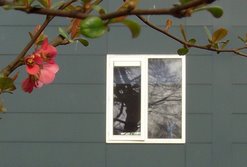
Last Saturday I read in my newspaper “Leeuwarder Courant” an item about the famous portrait of Johannes Vermeer “girl with a pearl” in which this painting was compared with two photographs with models. The photographs tried to imitate the painting. I came across that before: setting up a scene, as similar as possible to the painting (light, colour, position of figures, face, etc.) and always I get convinced of the superiority of the painting above the Photo. The Leewarder Courant published two photos: one of Scarlett Johansson in the film “Girl with a pearl earring” (2003) and one photo made by a mother, of her young daughter. I couldn’t get hold of the mother’s photo yet, but what I saw was a superficial similarity with the original, which was even stronger than the similarity between the original and the photo of Scarlett Johannnson. What struck me most, however was the facial expression in the three pictures. The original shows a girl who just heard the watcher saying something, or entering the room. What she hears is just enough to raise her interest, and she turns her head to the person who interrupted whatever she was occupied with (reading, playing the harpsichord, broidery). She is not startled not really surprised, her eyes are calm, but immediately showing a willingness to deep interest in what you as the watcher, and her “disturber” has to say, even more, what kind of person you are. It is really a frozen moment in time, to which no preparation took place and raising questions about what will follow. All that embedded in a masterly arrangement of form, light and colour. An ingenious piece of art, only comparable to the Mona Lisa. As a museumcard-holder I can watch her for free when I am in The Hague and take the effort to visit the Mauritshuis.
Then the mother’s picture. This girl is a little bit younger than Vermeer’s girl, but her face expresses a total different situation. She looks at her mother, wondering if she, at last, now looks the right way, wanting that it’s all over. Her eyes show no interest in who you, as a watcher, are or what you have to say. But the physical resemblance with Vermeer’s girl is really striking. Also the light is very similar, Vermeer shows more contrast in light-dark, only her blouse’s colour is green and Vermeer’s blouse is golden and shows almost no wrinkles or plies as in the photograph.

Then the photo of Scarlett Johansson. Here the promotion of the film is more important than resemblance with the original. What you see is a lady with a very sensible mouth, ready to kiss the watcher. She doesn’t turn her head to you in a movement that is goind on or has just been completed, no, she is already in conversation with you. Even the physical resemblance with Vermeer’s girl, who is clearly a modest and well-raised young lady, isn’t there, she wouldn’t dare making the suggestion to kiss you, it’s innocence and maybe a very little bit of curiosity and expectation that she radiates. Outright assertiveness and “I am in charge of the situation” is what Scarlett wants to express.
So this was another confirmation of my opinion that trying to imitate a painting, especially of such grandeur as Vermeer’s pearl girl, will only let the original shine more by its contrast with your attempts. I think the other way around this will also be the case, especially with portraits made by an excellent portrait photographer.
I ‘ll keep trying to find a publishable version of the mother’s photo to show you.
Then the mother’s picture. This girl is a little bit younger than Vermeer’s girl, but her face expresses a total different situation. She looks at her mother, wondering if she, at last, now looks the right way, wanting that it’s all over. Her eyes show no interest in who you, as a watcher, are or what you have to say. But the physical resemblance with Vermeer’s girl is really striking. Also the light is very similar, Vermeer shows more contrast in light-dark, only her blouse’s colour is green and Vermeer’s blouse is golden and shows almost no wrinkles or plies as in the photograph.

Then the photo of Scarlett Johansson. Here the promotion of the film is more important than resemblance with the original. What you see is a lady with a very sensible mouth, ready to kiss the watcher. She doesn’t turn her head to you in a movement that is goind on or has just been completed, no, she is already in conversation with you. Even the physical resemblance with Vermeer’s girl, who is clearly a modest and well-raised young lady, isn’t there, she wouldn’t dare making the suggestion to kiss you, it’s innocence and maybe a very little bit of curiosity and expectation that she radiates. Outright assertiveness and “I am in charge of the situation” is what Scarlett wants to express.
So this was another confirmation of my opinion that trying to imitate a painting, especially of such grandeur as Vermeer’s pearl girl, will only let the original shine more by its contrast with your attempts. I think the other way around this will also be the case, especially with portraits made by an excellent portrait photographer.
I ‘ll keep trying to find a publishable version of the mother’s photo to show you.






















